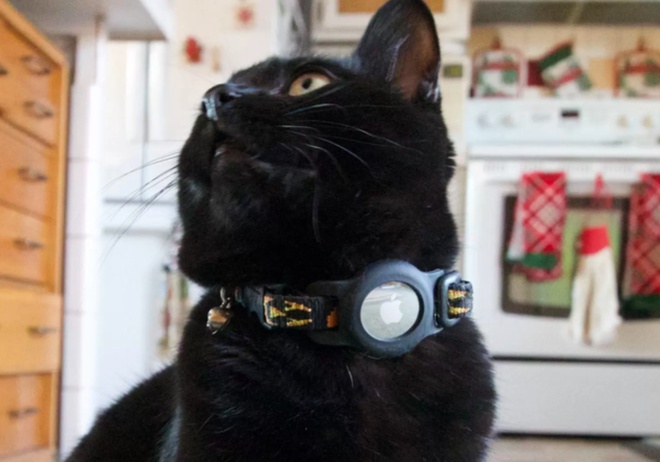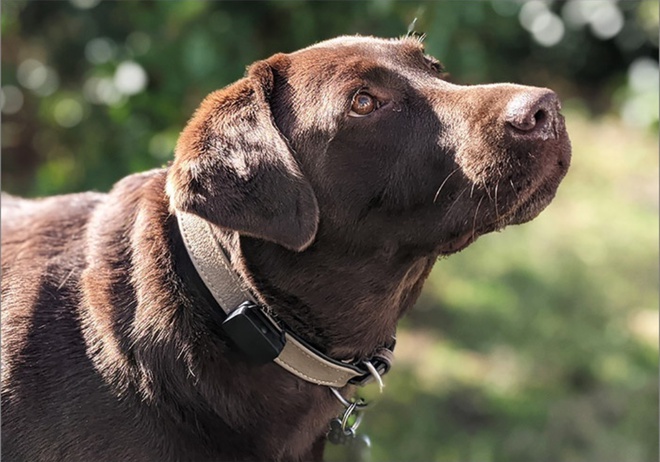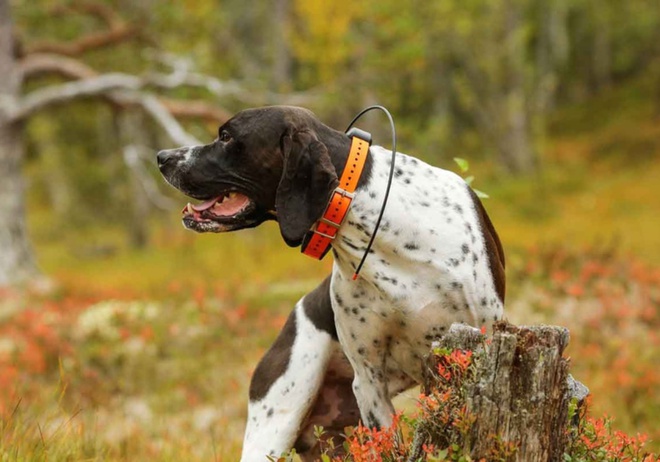How to choose the best GPS tracker for your pets without subscription?
It's not always easy to choose among all the existing GPS collars. In this article, you will find an overview of the different no-subscription technologies, as well as the strengths and weaknesses of each option.

Reading time : 7 min
It is important to choose the right GPS tracker for your cat or dog, because it is an essential element of its safety. So how to make the right choice of GPS tracker without monthly fee for your pet? You will find in this article all the information about the existing technologies that offer geolocation without subscription, their advantages and disadvantages, but especially if they are really adapted to pets.
SUMMARY
The Bluetooth tracker for cats and dogs

In theory, Bluetooth trackers allow easy and quick geolocation of everyday objects like keys or a wallet. Their use has evolved over time and some people now attach a connected keychain to the collar of their cat or dog. But is it really a good idea?
Bluetooth technology
A Bluetooth tracker is a locator which works thanks to the Bluetooth technology and which is able to locate objects at a distance of 164 ft. maximum (in optimal conditions: clear environment). Today, the manufacturers of Bluetooth GPS have introduced the concept of crowd GPS. Thus, this signal which could initially be received at a distance of 164 ft. (50 meters) maximum, can now be extended thanks to the community of smartphones in the immediate vicinity of the tracker. The tracker will retrieve the position of another terminal passing by (usually a phone) and update its location, which allows localization at a longer distance.
Advantages and disadvantages
This tracker will allow you to locate your pet very accurately within short range and indoors. It is also inexpensive, count about thirty dollars, and the battery life is about 1 year. Moreover, it is a small object that fits well with the size of cats and dogs.
On the other hand, this system makes localization beyond 164 ft. hardly possible because it depends on the community present around the tracker. This means that in rural areas or sparsely populated ones, this type of technology will work less efficiently or not at all. In addition, the crowd GPS system will only work if the GPS and Bluetooth of the person passing by are turned on. Finally, you won't have real-time tracking, so you won't be able to find your pet if it starts moving again (which they do almost continuously).
We can therefore say that this type of device is not suitable for the GPS tracking of a pet. It is therefore better to turn to another technology.
Some examples of brands
Among the Bluetooth trackers, let's mention of course the Apple Airtag. It has the disadvantage of not having any specific attachment, so you will have to buy an (expensive) accessory to attach it to your pet's collar. Note that the brand itself specifies that it is not suitable for tracking pets.
We can also mention the American company Tile, which specializes in this type of tracker and offers a less expensive alternative to the Apple product.
The low power GPS tracker for cats and dogs

The Sigfox and Lora networks
The Sigfox and Lora networks were created a few years ago specifically to support the rise of connected objects. They operate on open frequencies that allow manufacturers to bear less costs, since there is no fee to pay for their use. This allows them to offer a service with no subscription, or with a subscription included in the price of the tracker.
Advantages and disadvantages
The main advantage of this type of tracker, apart from the fact that they work without subscription, is the life span of their battery. In most cases, you will benefit from an autonomy of several days at least, even weeks. Note also that unlike Bluetooth trackers, they work without any distance limitation. They are also autonomous, as they recover the position of their GPS by themselves.
However, the fact that they use open and public frequencies cause a delay in the processing of messages, due to network saturation. The limited number of daily messages (to avoid saturation) is also an obstacle to real-time location; because you will not have as many positions as you want in a given period of time (only 5 positions in one hour for example).
In fact, real-time tracking is only possible if the messages sent by the tracker are sent every 5 to 10 seconds. With a limited number of messages per day and a regular saturation of these networks, real time is difficult if not impossible. In case of loss of your pet, time being an essential element, your search will undoubtedly be more complicated.
We can therefore conclude that this type of tracker is not adapted to the location of a cat or dog either. It is better to turn to another technology.
Some examples of brands
As these networks are not adapted to pet tracking, few brands use them for this purpose. Let's mention the French company Invoxia, whose trackers are more adapted to the tracking of a vehicle or tracking of a bike.
Other brands existed in the past, but they disappeared over time because they did not meet the final need for animal safety.
Things to check before buying a GPS
18 questions you need to ask yourself before buying a GPS tracker for your loved ones!
The radio frequency dog tracking collar

Radio frequency
Finding your lost dog with a no subscription GPS tracker is possible thanks to radio frequency. In fact, Garmin products are very popular with hunters to find their dog in dense forests and / or increased white zone for example. The radio frequency works thanks to a transmitting collar and a GPS receiver, it is the same principle as a walkie-talkie.
Advantages and disadvantages
The first advantage of this type of technology is that it allows for real time localization, without no limitation of messages, which is quite nice when you think about the two technologies presented earlier in this article. Radio frequency also allows to not depend on traditional cellular networks. So there is no risk of being cut off in case of a white zone. This explains their widespread use in dense forests, especially for hunting.
On the other hand, this type of tracking collar works with a distance limit of a few miles only. Beyond that, the signal is lost and it is no longer possible to find the pet. Also, this type of tracker allows for only one user (the one who owns the receiver), which can be a problem for families. Finally, the price is very high (not to say prohibitive) since it costs nearly $1,000 USD for a single device. It should be noted that they do not offer any other feature than tracking, such as an anti-runaway alert for example.
Although tracking collars are adapted to the specific use of localization in forests, they will be less suitable for a more traditional use such as securing your walks with your pet. They will not allow you to prevent your animal from running away either. Finally, they are completely unsuitable for tracking cats, because of their size and weight.
Some examples of brands
Some of the best known brands of tracking collars are Garmin or Dogtra. These are all brands dedicated to hunters, with products costing several hundred dollars. There used to be consumer brands for this type of tracker, but unfortunately this is no longer the case.
The GPS collar for cats and dogs with subscription

You should know that a lost animal is often panicked and that for its owner it generates an enormous amount of stress. Finding a living being is complex but not impossible. Certain factors must be taken into account: the fact that pets move constantly, and that they can go far, even very far if they are lost...
For this reason, the purchase of a GPS tracker to better locate your pet is essential. But how to make sure it will not let you down when you need it? This necessarily involves choosing a GPS collar with subscription. Let us explain.
Real time tracking
In order to find your doggie or your fur ball quickly and easily, you need to be able to follow it in real time. Unfortunately, as we have seen earlier in this article, GPS devices with no subscription do not offer real time tracking. The exception is radio frequency, but that has too many downsides, including price and distance limitations.
Real-time tracking is the most important element to find your lost cat or dog. Indeed, it is most probably scared and totally disoriented. It will hence move continuously hoping to find a shelter or find its home. You absolutely need to have location information updated as frequently as possible.
The subscription-based GPS tracker is sold with a SIM card. This SIM card allows you to be continuously connected to the manufacturer's server and to send unlimited messages. This ensures optimal real-time tracking.
Tracking with no distance limitation
The GPS tracker with subscription is autonomous and communicates its position by itself. Unlike Bluetooth trackers for example.
As long as there is a GSM network, the tracker will send its position permanently throughout the country and often even abroad (for those who live near a border for example). This is what manufacturers of subscription-based GPS trackers for dogs and cats offer.
In addition, the coverage is often multi-network, which limits the impact of white zones on the functioning of the GPS collar. You will always be able to find your pet, wherever it is.
Additional features
Subscription-based GPS trackers often offer additional useful features. For example, the anti-runaway alert, or the existence of a ringtone or a vibrating device, which allows you to train your pet and to make it come back to you if it goes too far away for example.
Conclusion
Locating an object, a vehicle, or a pet are totally different uses. Indeed, each of these uses requires a specific technology. To make the right choice, it is essential to start from your use and find the product that best meets the associated need.
Your dog or cat is a full-fledged member of the family and needs a tracker that guarantees its complete safety. In this regard, it is essential to have access to real time tracking AND no distance limitation. Only subscription-based products meet this need. GPS devices with no subscription are not suitable for cats and dogs.
Continue reading our guide
This article is part of a complete guide on the subject. Do not miss the next chapters.
Are you looking for the best GPS tracker ?
18 questions you need to ask yourself before buying a GPS tracker
